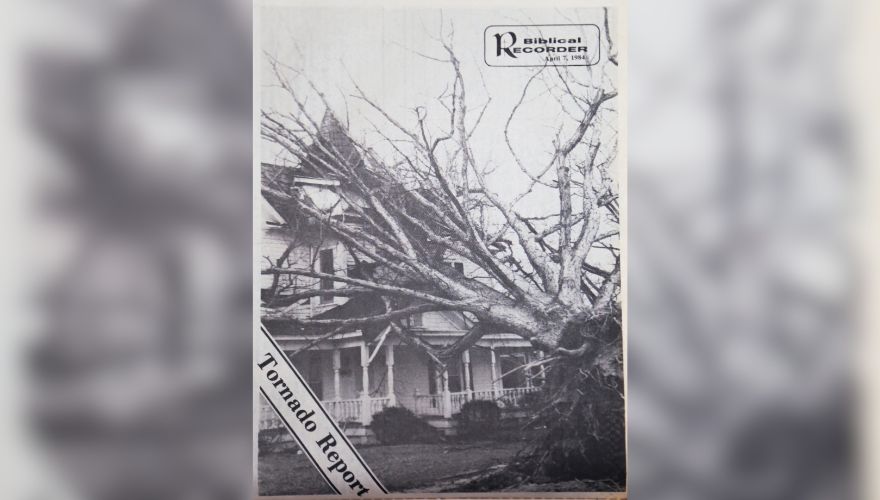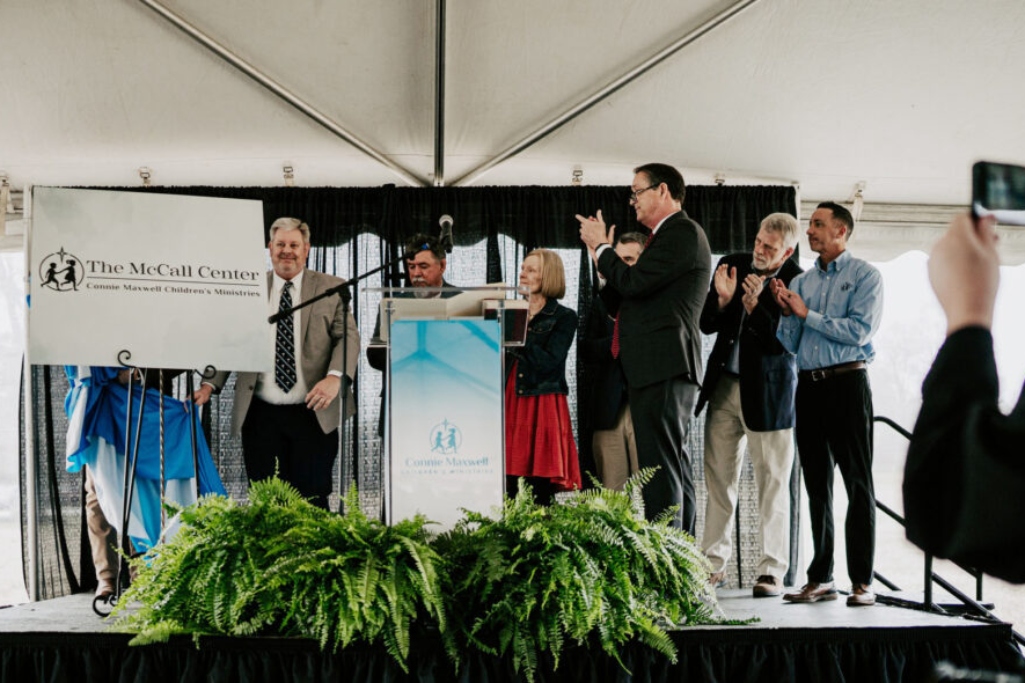The Biblical Recorder devoted special coverage to the tornadoes that struck the state and led to N.C. Baptists’ first-ever disaster relief response in March 1984.
RED SPRINGS, N.C. – Like many residents of Red Springs, Elnora Hollingsworth will never forget what March 28, 1984, was like or the events that took place that day.
“It was a beautiful day,” Hollingsworth remembers. “Just so calm.”
But it was the calm before the storm.
Hollingsworth was returning home from supper at a seafood restaurant just a few miles outside of town when she learned that a tornado had ripped through the region.
“We didn’t know anything had happened until we drove up to the first stoplight,” Hollingsworth said. “There was a gas tanker sitting there, and the driver was screaming, yelling at us not to go any further. He said, ‘I think a tornado has hit this town.’”
The twister that tore through Red Springs in Robeson County at approximately 7:30 p.m. that evening was part of the deadliest and most destructive tornado outbreak in the history of the Carolinas. All told, the band of storms that swept across the South that day produced a total of 24 confirmed tornadoes – 11 in North Carolina, 11 in South Carolina and two in Georgia – that collectively resulted in 57 deaths, more than 1,200 injuries and millions of dollars in damage.
The storm system impacted numerous counties across southeastern and eastern North Carolina as it moved more than 200 miles in a northeasterly direction all the way from the Sandhills to the Outer Banks. Red Springs was among the hardest hit places in the state as the storm ravaged the town’s business district, leveled an elementary school, downed trees on streets and homes, and knocked out power and telephone service.
“It was like a battle zone,” said Dickie Nye, a lifelong Red Springs resident.
Yet the storm that caused so much devastation and destruction 40 years ago gave birth to a brand new ministry among N.C. Baptists that would ultimately grow to become one of the most visible in the state and beyond.

An emerging ministry
In the 1970s, N.C. Baptist leaders began exploring ways to engage in an emerging ministry in Baptist life – disaster relief. The first ever disaster relief response by any Baptist group came in 1967 when Texas Baptists assisted victims of Hurricane Beulah, a Category 5 storm that struck the Lone Star State.
With help from Texas Baptists, North Carolina was among a handful of states looking to begin its own ministry to respond to natural disasters.
By the early 1980s, N.C. Baptist Men, an auxiliary of the Baptist State Convention of North Carolina which is now known as Baptists on Mission, acquired a tractor trailer unit which was housed at Caraway Conference Center near Asheboro. On weekends, volunteers traveled to Caraway to work on outfitting the trailer with equipment so it could be deployed in the aftermath of a natural disaster.
The morning after the tornado hit Red Springs, N.C. Baptist Men received a call requesting assistance, which pressed the new disaster relief unit into service a little sooner than originally planned. (See accompanying story.)
But by 6:30 p.m. on Thursday, March 29, 1984 – a little less than 24 hours after the tornado touched down and hours after receiving the call for help – the disaster relief unit and a team of N.C. Baptist volunteers set up shop at First Baptist Church of Red Springs, where they operated a mobile kitchen to prepare and serve hot meals to people in need.
Hollingsworth, a member of the church, was among those who helped serve meals.
“We just took turns helping out,” Hollingsworth said. “I remember we fed a lot of people. We were handing the food out as fast as we could hand it out. It was busy.”
Preparing and serving meals to those impacted by the tornado outbreak in Red Springs 40 years ago marked the very first disaster relief response by N.C. Baptists. Over the coming decades, the ministry would grow to encompass much more, with teams and equipment deploying to assist people impacted by natural disasters near and far.

Learning and growth
In 1984, Richard Brunson was in the midst of working on his seminary degree at Southeastern Baptist Theological Seminary in Wake Forest. He also worked part-time with N.C. Baptist Men and traveled to Red Springs to serve on the brand new disaster relief unit.
As N.C. Baptists joined the likes of the National Guard, the American Red Cross, local and state first responders, government officials, and other volunteers, Brunson remembers wondering if people thought, “Wow. What are Baptists doing getting involved in disaster relief?”
Today, Brunson serves as executive director of Baptists on Mission. Disaster response is one of 19 different ministries the organization is engaged in, and Brunson has had a front row seat to witness the expansive growth the ministry has experienced since that initial deployment to Red Springs 40 years ago.
“That was the first time we responded to a disaster as N.C. Baptists, so there were a lot of things we were learning,” Brunson said. “I don’t think anybody ever imagined what it would become.”
Through the years, God provided more and more volunteers and equipment, which expanded how Baptists on Mission ministers and serves victims of various natural disasters. What began with volunteers serving meals in Red Springs after the tornadoes has grown to include chainsaw crews to remove fallen trees, mudout and tearout teams to remove muck and debris from homes after flooding, and, more recently, rebuild teams who help families put their homes (and lives) back together after a disaster.
Brunson said the ministry has grown by people seeing needs and meeting them.
“It’s been people realizing they have gifts that God can use to make a difference in people’s lives for His glory,” Brunson said. “That’s how disaster response has grown.”
Today, Baptists on Mission has thousands of disaster response volunteers across the state and owns a convoy of vehicles and equipment to assist in times of need. In addition to multiple feeding units, Baptists on Mission owns multiple shower units, laundry units, generators, fork lifts, skid-steer loaders and more.

The increases in volunteers and equipment over time coincided with more opportunities to serve. Five years after the Red Springs tornadoes, Baptists on Mission volunteers responded to needs after Hurricane Hugo reached inland as far as Charlotte and beyond in 1989. The Hugo response was considered another catalyst in the growth of the ministry, as was the response to Hurricane Andrew, which saw more than 3,000 N.C. Baptist volunteers deploy to South Florida following the Category 5 storm in 1992.
The ministry continued to grow throughout the 1990s, which saw numerous N.C. Baptists respond to Hurricanes Fran (1996) and Floyd (1999) here at home, as well as Hurricane Mitch in Honduras in 1998. In the 2000s, the Sept. 11 terrorist attacks in 2001 took disaster response to another level, as did the response to Hurricane Katrina that struck New Orleans and the Gulf Coast in 2005.
More recently, N.C. Baptists have maintained a long-standing presence in southeastern North Carolina following Hurricane Matthew in 2016 and Hurricane Florence in 2018. (See accompanying disaster response timeline.)
“It’s amazing to think back about how God has provided all of this equipment and put it on the hearts of volunteers to serve,” Brunson said. “It’s what God has done, it’s not what we have done. God has continued to give us opportunities to serve, and it’s all for His glory.”

Faithful to serve
For Brunson, who has been around from the beginning of N.C. Baptists’ disaster response ministry through the present day, a pair of verses from the Gospel of Luke frame his perspective.
In the early days, it was Luke 16:10, the opening words of which read, “Whoever is faithful with very little will also be faithful with much.”
“There were a lot of people in those early years who were faithful with little, and God has entrusted us with more,” Brunson said.
Case in point. During that initial response in Red Springs, N.C. Baptist volunteers helped prepare and serve about 8,000 meals in a little more than a week. Now Baptists on Mission owns mass feeding units capable of serving up to 30,000 meals in a single day.
“At the end of our time in Red Springs, we were amazed by being able to do those 8,000 meals,” Brunson said. “Since then, God has provided us with equipment that allows us to do 30,000 in one day, and we’ve had to do that many times through the years.”
Which brings us to Luke 12:48, the second verse that shapes Brunson’s current perspective related to disaster response: “To whom much has been given, much will be required.”
One of the phrases Brunson repeats often is that every Christian is called, gifted and sent to be on mission, and he’s worked to provide opportunities for N.C. Baptist churches and their members to live out that calling. One of the ways Baptists on Mission provides such opportunities is through the three mission camps it operates across the state – including one in Red Springs – which work with churches to engage them in local missions projects.
Moreover, many N.C. Baptist churches and local Baptist associations have their own disaster recovery trailers, filled with their own tools so teams of volunteers can respond to damage caused by localized storms or deploy to major disasters that garner major headlines.
Nye, who likened the aftermath of the 1984 tornadoes to a “battle zone,” currently serves as the deacon chairman at First Baptist Church of Red Springs and coordinates the church’s long-standing Baptist Men’s ministry. Nye has served on teams from the church that have responded to local storms, and several members of the church joined Baptists on Mission’s response to Hurricane Katrina in 2005.
Nye was among those there in Red Springs to witness N.C. Baptists’ very first disaster response and see what the ministry has ultimately become.
“We didn’t know much about Baptist Men back then,” Nye said. “Now when you hear about a disaster, you expect to see Baptists responding.”
(EDITOR’S NOTE – This article originally appeared in the March/April 2024 issue of the Biblical Recorder magazine. To listen to a related podcast, click here.)

